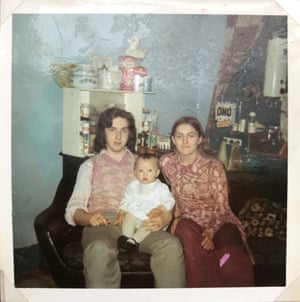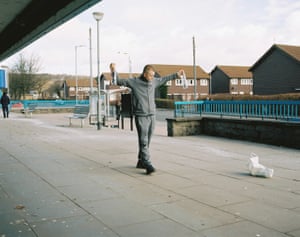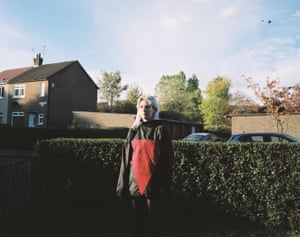[ad_1]
‘At first I wanted to photograph issues, but I came to realise that this is a story about trauma – the ripple effect of trauma, how trauma is passed on from generation to generation.” That is how the Scottish photographer Kirsty Mackay describes her project The Fish That Never Swam, a quietly powerful study of low life expectancy in Glasgow through a series of compelling portraits.
Mackay began shooting the series in 2016, after the Glasgow Centre for Population Health published research into Scotland’s so-called “excess mortality” – 5,000 more people die in Scotland per year than the UK average. Glasgow is at the centre of that spike: at 73.3 years, male life expectancy in the city is the lowest in western Europe, which has given rise to the term “the Glasgow effect”. Going beyond the poverty and deprivation that are the main causes of poor health in any society, the report flags up other contributing factors, in particular Glasgow’s controversial housing policy in the 1970s.

-
Ellen, 51, moved to Easterhouse in 1973, aged five. As a young woman she worked in the bingo hall in the Red Road flats. She has three children and four grandchildren.
That policy – of breaking up working-class neighbourhoods and rehousing their inhabitants in estates on the edges of town – cut people adrift from their community support networks and left them particularly vulnerable to the mass unemployment of the 80s. “There was so much disruption in housing, working-class communities lost their roots,” says Mackay, who herself grew up in Glasgow. “People had to start all over again.”
Mackay’s project focuses on individuals whose life and experiences “tell part of the city’s story”, including those from the “big four” estates – Pollok, Drumchapel, Castlemilk and Easterhouse. There’s Billy McMillan, for example, an articulate young man from Easterhouse whose teachers ruled out further education. There’s Wee John, pictured on the border between Drumchapel and Bearsden, where male life expectancy varies massively depending on which side of the divide you’re on.

-
Wee John, pictured on the border between the Drumchapel and Bearsden, where male life expectancy varies massively depending on which side of the divide you come from.
Then there’s Liz, a young woman who lost her partner to suicide in 2015, a not uncommon experience. Suicide rates are higher in Glasgow than in any other Scottish city, and are considerably higher in Scotland than in England.
“Suicide came up again and again,” says Mackay. “I couldn’t ignore it. What I wanted to do was photograph the people who have been left behind – not just the deaths but the impact they have.” She adds that the subject resonates on a personal level: Mackay witnessed two suicides when she was growing up, one on her way home from school. “People taking their own lives, and some of the other things I saw – that has had an effect,” she says. “These are things I had put away, but doing the project has brought them back up again.”

-
Kirsty Mackay pictured with her parents in Maryhill, 1971. ‘This was the first flat I lived in. It was a victorian tenement flat called a “room and kitchen”. We had this room and one bedroom, the toilet was on the landing shared with the neighbours.’ Courtesy of Kirsty Mackay
“What is it like to come from this place, as opposed to any other place, and how does that shape you?” Mackay asks in her introduction to The Fish That Never Swam; its title is taken from Glasgow’s coat of arms, and also evokes the idea that, just as a fish is not aware of the water it swims in, it’s hard for an individual to grasp the impact their environment has on them. “That’s why I wanted to photograph a baby,” says Mackay. “I wanted to make a point about your place of birth and how it affects your life.”
Born in Maryhill, Mackay moved to Partick with her family when she was three, and grew up in a working-class tenement block near the River Clyde. Partick was a mixed area next to the more prosperous Hillhead district, and Mackay says that growing up seeing those differences made a difference. “There was a lot of diversity, and I definitely aspired to have one of the houses at the top of the hill,” she says. “That’s what you don’t get in these peripheral estates.”

-
Debbie’s newborn baby asleep in the Scottish baby box, which provides a safe place to sleep and comes full of baby essentials. The box was introduced by the Scottish government in 2017 to tackle infant poverty rates and is designed to give each child born in Scotland ‘the best start in life’.
Encouraged by a teacher, Mackay studied photography at Glasgow College before leaving for New York and London to work as assistant to photographers including Herb Ritts, Nick Knight and Anton Corbijn. She has an MA in documentary photography from the prestigious school of photography at the University of Wales and has said that her work is fuelled by “injustice on any scale”. Now settled in Bristol, she published her first book, My Favourite Colour Was Yellow, an exploration of the colour pink and the way it’s pressed on young girls, in 2017.
Mackay’s accent may have softened over the years since she left but, she says, Glasgow still feels like home – and her mother still lives in the flat she grew up in. “I’m an insider and an outsider,” she says. “When I was making this work I was really aware of that.”

-
A young man shows off his ‘carry-out’ of vodka outside Drumchapel shopping centre. ‘I’d like to take the narrative away from the symptoms of these health inequalities towards the root causes,’ says Mackay. ‘The focus needs to shift from the individual to the legacy of political policy.’
That sense of being an outsider meant she sometimes questioned her right to make the series, but two factors spurred her on. First, she wanted to get the research from the Glasgow Centre out to the wider public, “because there was only a couple of articles about it in the papers”. But second, she hopes to add more insight from her subjects, because “it’s the people with lived experience that have the answers.
“I’m travelling all around the city, talking, and most crucially listening, to a diverse group of people,” she says. “I see myself a bit like a conductor bringing all these voices and life experiences together; my hope is that the result will be a chorus of voices that point the way to the next chapter of action.” To this end, the series will be published as a book next year and there’s also a documentary film in the making.

-
Liz lost her partner Andy to suicide in 2015, and is pictured here wearing his jacket. ‘He died about a week before his 28th birthday. If he’d have had professional help things could’ve been a lot different. I think there is help out there, but it’s very hard to access.’
Mackay says she usually takes the time to get to know her subjects, collaborating with them on their portraits and frequently photographing them at home. One lady wanted to get her hair done and change her outfit before their session, for example, another wanted to be shot looking sultry. “She said ‘When I die, use this picture of me at the funeral,’” says Mackay. “That’s really the highest compliment.”
She works this way not only because she doesn’t want to depict her subjects as victims but also because it’s important that the images reflect the sense of personal pride that people in Glasgow have, despite – or perhaps because of – the challenging circumstances in which some of them live. “People take a lot of care over how they present themselves to the world. Their houses are spotless and they put money into dressing their kids,” she says. “It’s something they have power over.”

-
Kaitlin, 23, at home in Springburn. ‘I’ve been diagnosed with a chronic illness, been through two blocks of therapy, left uni, started a new job,’ she says. ‘I feel it in my bones that good things are going to happen for me soon. I am powerful amazing and ready.’
[ad_2]
READ SOURCE


